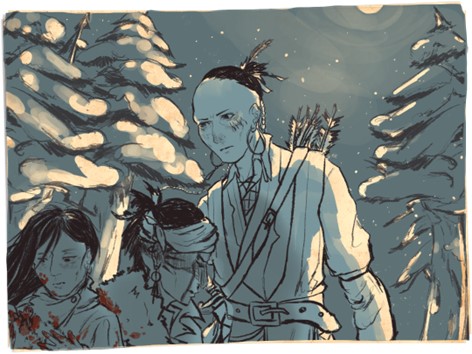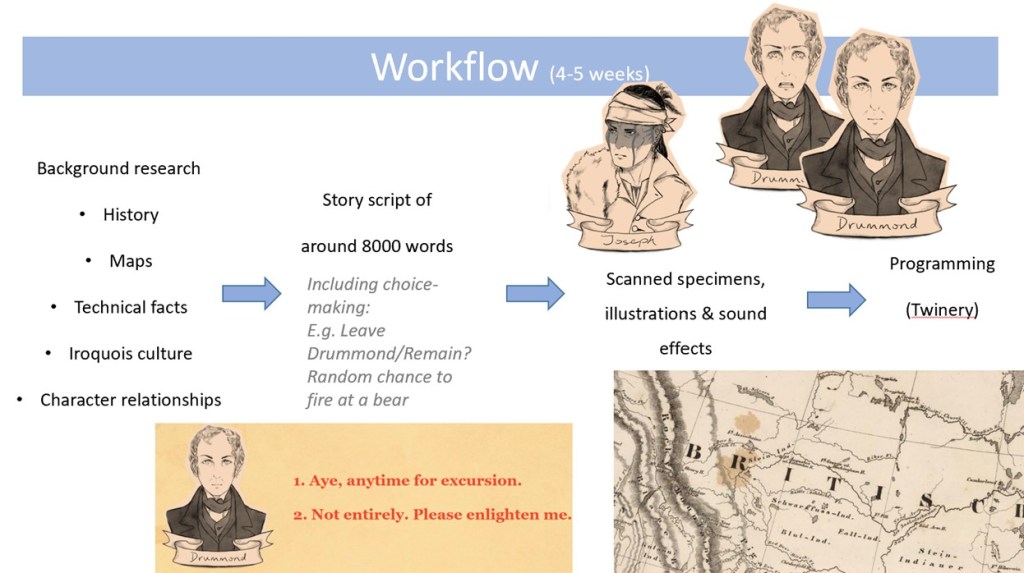Written by Su Liu, BA English Language and Literature student at the University of Sheffield, formerly summer intern (2023) at Amgueddfa Genedlaethol Caerdydd – National Museum Cardiff.
Thomas Drummond, a Scottish naturalist, witnessed the tragedy of his accompanying Native American family – the Iroquois hunters had just lost their beloved and a newborn in the severe winter of Saskatchewan, Canada. Yet their journey had to be continued to collect the 286 specimens in Drummond’s Musci Americani, one of the richest collections of North American mosses.
‘…the whole of the continent of North America has not been known to possess so many Mosses as Mr. Drummond has detected in this single journey.’ – Sir William J. Hooker (1830)
Above is a real event in Drummond’s Sketch of a Journey to the Rocky Mountains and to the Columbia River in North America, which records his excursions during Franklin’s second land expedition. It has been adapted into an interactive digital narrative, Snow, Bonfires and Mosses, in which the reader engages with a combination of novel, visualisations, sound effects and choice-making. Choice-making allows the reader to experience different narratives and explore possibilities amid ambiguities in history.
This browser game is accessible on most devices and comes with an ‘encyclopaedia’ that includes a selection of Drummond’s moss specimens and external links to the biographies of all historical characters.

Lost stories of a distant adventure and forgotten collectors
The story of Drummond’s adventure began in Saskatchewan, 1825, where he parted ways with Franklin’s party and was joined by Iroquois hunters employed by Hudson’s Bay Company, a dominant fur trading company at the time. Their journey near the Rocky Mountains was an underdeveloped version of Man vs. Wild, surrounded by hunger, blizzards, wildlife, and humans – conflict between different tribes continued regardless of the Europeans’ intrusion.
Drummond made excursions whenever he had the opportunity, followed by sleepless nights when he had to treat his specimens before the fur brigade departed. At times, he failed to follow the fur brigade’s pace and consequently much of his work was lost or destroyed. By the time he was brought back to reality from work, he realised that he had been left ‘alone with the Indians’.

In contrast with Drummond’s objectives, the emphasis of the expeditions had been more on the exploitation of new trading routes. The capitalist powers were eager to establish colonial influence in North America and appeared to have taken local labour for granted, so the natives were not having a great time either. Drummond sometimes found the ‘fickleness’ in them hard to deal with but nevertheless depended on their work.
My colleague and BA history student Harry Pointon has pointed out the conventionalised indifference towards local hunters in the early 19th century, whose contributions are acknowledged in Drummond’s Sketch due to the complexity of his journey, as the natives play essential roles in the naturalist’s survival and are experienced guides to the flora in their natural habitat. With that in mind, my digitalisation of the exsiccatae (numbered collections of dried herbarium specimens with a common theme or title) goes in tandem with decolonising the history of the participants, especially the Native Americans.
Behind the scenes of Snow, Bonfires and Mosses
I had a blast writing, drawing and programming to make historical science approachable without being a bore, especially for slightly older children. It was hard to imagine myself working on two-hundred-year-old mosses as an English student, but I was beyond excited to see moss specimens in a great variety of sizes and colours. With the help of the Biodiversity Heritage Library (BHL) and my supervisors, I was able to put together a full timeline of events without much barrier to scientific knowledge.
The historical accounts were quite a fun read. Early modern science writing (approximately from the 17th century onwards) consisting of all sorts of information, from each step of the experiments (even if it results in failure) to personal remarks from the researchers. Unlike contemporary science writing which aims to be brief and impersonal, these accounts are vividly descriptive, and they highlight the presence of all participants: naturalists, hunters and fur traders. Drummond’s Sketch is an excellent resource that conveys his passion for botany and has proven itself practical in helping me construct my storytelling of the specimens. It is also proof of Native American involvement in naturalist excursions.
Apart from the emphasis on Drummond’s excursions and specimens, the narrative also presents parts of Native American culture throughout the characters’ dialogues. Iroquois people, for example, tend to have a strong belief in astrology and female leadership. This will hopefully create a fuller image of the Indigenous collectors, their lives, and the ways they were treated by the Europeans.
As a literature student, my understanding of decolonising history is the liberation of artefacts from hidden archives and unravelling the stories of neglected participants in the most accurate detail as possible. Drummond’s Sketch is perhaps a fortunate case for decolonising the archive, considering the common lack of credit for Native Americans. It is encouraging to see readers entertained and captivated by the story, and hopefully this has been an inspiring attempt at digitalising and decolonising museum archives for educational purposes.

Further reading
My project was supported by the Transforming and Activating Places (TAP) programme at the University of Sheffield. My colleague Harry Pointon, who worked on the same topic, has written a blog post about the programme and the interdisciplinary aspect of his work as an arts and humanities student: https://tuostap.blogspot.com/2023/10/knowledge-exchange-has-no-boundaries.html



Pingback: Thomas Drummond | Pearltrees
Pingback: NatSCA Digital Digest – May 2024 | NatSCA